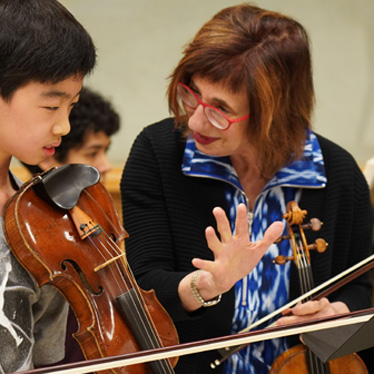StringOvation Exclusive: Mimi Zweig’s Roadmap to Success

Sooner or later, most people find themselves at a crossroads in their career. Mimi Zweig arrived there early. As detailed in part I of this three-part series highlighting Zweig’s career, she was already an accomplished violinist and violist at the age of 22.
It was 1972 and Zweig was a member of the Piedmont Chamber Orchestra, which was in residence at the North Carolina School of the Arts. A year prior, she earned a Bachelor of Music degree from the State University of New York, Albany. Many opportunities were open for such a talented musician.
“In those days, you could play in an orchestra. You could be a chamber musician,” Zweig said. “There was less competition and it was assumed that one could make a living.”
But which opportunity should she pursue? It turned out to be the one to which she hadn’t given much thought, and this was working with children.
After somewhat skeptically deciding to observe a teacher who had just arrived in Winston-Salem, NC to develop a violin program (Nancy Kredel), her second passion bloomed. Her first passion was studying music and playing the violin. A discovery that began when she was eight years old in the small northern California town of Davis. And like the new calling that followed less than a decade-and-a-half later, it was love at first sight.
“I loved the violin and classical music from the very beginning,” Zweig, now nearing 70, said about her early years as a student. “I loved to play and I loved to practice.”
By the end of Nancy Kredel’s lesson, Zweig was taken in. For the next year, Zweig went on to apprentice in this program. In the next years she developed violin programs in Pittsburgh, at the Wisconsin Conservatory of Music in Milwaukee and the String Academy of Wisconsin at the University of Wisconsin-Milwaukee. She is now a Professor of Violin at the Jacobs School of Music where she teaches university students, pedagogy classes, and directs the String Academy which she began in 1976. The Indiana University Summer String Academy launched in 1984, and will celebrate its 36th anniversary this summer. By her late 20’s, Mimi had decided to dedicate her life to teaching and to helping students cultivate their dreams.
Her performing résumé includes the American Symphony Orchestra, Syracuse Symphony, and the Indianapolis Symphony Orchestra. Today her String Pedagogy website, which has evolved over nearly 20 years, gives teachers, students, and parents around the world free* access to learning materials created by Zweig, and her colleagues Brenda Brenner and Susan Moses. This website offers a wealth of pedagogical information coupled with almost 200 teaching videos.
A Teacher is Born
Long before Oprah Winfrey and Taylor Swift became emblematic of female empowerment and entrepreneurship, Zweig, intuitively, was showing us how it’s done. Graciously taking time from a recent, short sabbatical (actually a ‘half-sabbatical,” as she put it — more on that later) to discuss her life and career via a video interview, she more than once mentioned “the audacity of youth” that propelled her forward.
Sitting in front of her computer, an ornate wooden music stand can be seen behind her. Sheet music is open. It seems a fitting metaphor. Besides embracing music from such an early age, Zweig projects a keen sense of style. Her always expressive face is adorned with a playful and stylish pair of red glasses. The frames were designed by noted architect/designer/artist Ron Arad, the brother of her life partner, violist and composer, Atar Arad. Like Zweig, Atar Arad is a professor of music at the Jacobs School of Music.
Blazing Trails
When she was still in her early twenties, Zweig didn’t wait long to jumpstart her career soon after arriving in Pittsburgh, PA, in those years very much the Steel City. Mimi is soft-spoken and petite. You might be tempted to think she’s a little shy, but a wallflower she isn’t. Changing her voice and adopting an inflection to portray young Mimi puffing herself up, she smiled and said “With the audacity of youth, I went to the Jewish community center in Pittsburgh and said, ‘I’m Mimi, I know how to teach kids and I want to set up a string program for you!’ They said ‘OK.’”
She went on, “I then went to the local music store and said the same thing and they said ‘OK.’ Then I went to another community near Pittsburgh and did the same thing. By the end of the year I had 45 students and they were thriving!”
Two years later, she moved again, this time to Bloomington, IN, in one of college basketball’s most hallowed cities, Mimi showed that she had game. Miriam Gelvin, a now deceased professor of music education, was looking for someone to develop a violin program.
“I just showed up on the scene at the right time. I was very lucky,” Mimi says. “The administration said ‘Fine, let’s give her space and let her establish a program — as long as it doesn’t cost the school anything.' It is amazing to think that this could happen because I was an unknown with little credibility. They took a big chance. After three years I had too many students! That’s when I was given my first graduate assistant, Rebecca Henry who is now teaching at Peabody where she has developed a thriving program.” Mimi also began teaching university viola students and not long after that, the university brought her on full-time. “I had so many students that they had to offer me a position!” she laughs.
Today, there are 1,600 students at the Jacobs School and 160 in the String Academy. This includes over a hundred violinists, a few violists and 25 cellists. The Summer String Academy attracts aspiring musicians from all over the world.
About that “half sabbatical” mentioned earlier? Zweig explained that her workload is too demanding to expect her sabbatical replacements to carry on alone. So, she spent some of her downtime working.
That’s just Mimi. Passion. Dedication. Love.
Read part I of our interview with Mimi Zweig. Article sponsored by Thomastik-Infeld.
Coming in part III of this series: Mimi develops her style of pedagogy, joins the digital age and discusses her future. We also get an inside look at Mimi’s home life.
*Access to StringPedagogy.com is provided free thanks to Connolly Music and Thomastik-Infeld of Vienna.
 Michael Harrison is a lifelong journalist, currently living in Fort Mill, South Carolina, where he was the editor of the local newspaper, the Fort Mill Times, 2004-2018, and earned dozens of South Carolina Press Association Awards. A native New Yorker, he was once first runner-up for the New York Press Association Writer-Of-The-Year award. He’s currently a freelance writer/content creator and runs a local news site, the MillTown News.
Michael Harrison is a lifelong journalist, currently living in Fort Mill, South Carolina, where he was the editor of the local newspaper, the Fort Mill Times, 2004-2018, and earned dozens of South Carolina Press Association Awards. A native New Yorker, he was once first runner-up for the New York Press Association Writer-Of-The-Year award. He’s currently a freelance writer/content creator and runs a local news site, the MillTown News.


